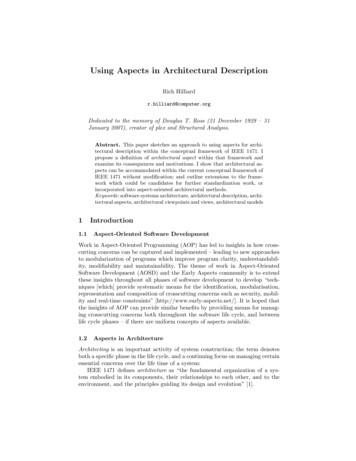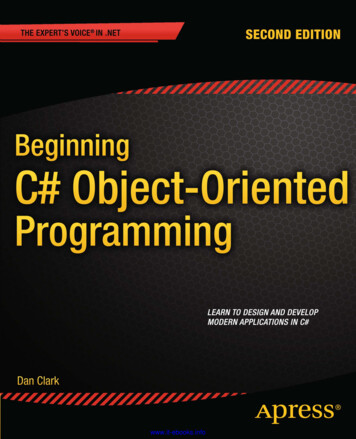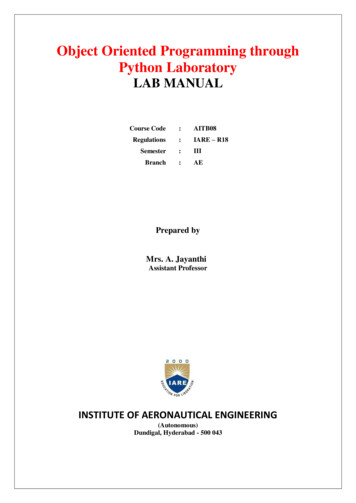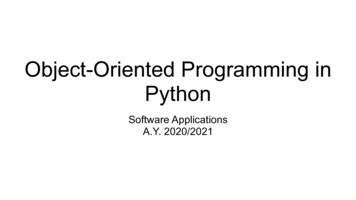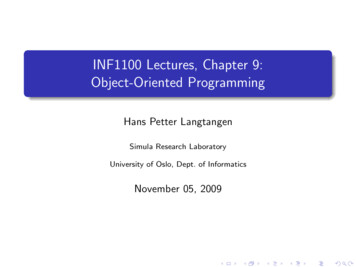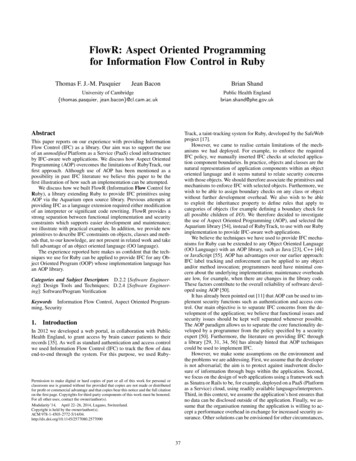
Transcription
FlowR: Aspect Oriented Programmingfor Information Flow Control in RubyThomas F. J.-M. PasquierJean BaconBrian ShandUniversity of Cambridge{thomas.pasquier, jean.bacon}@cl.cam.ac.ukPublic Health Englandbrian.shand@phe.gov.ukAbstractTrack, a taint-tracking system for Ruby, developed by the SafeWebproject [17].However, we came to realise certain limitations of the mechanisms we had deployed. For example, to enforce the requiredIFC policy, we manually inserted IFC checks at selected application component boundaries. In practice, objects and classes are thenatural representation of application components within an objectoriented language and it seems natural to relate security concernswith those objects. We should therefore associate the primitives andmechanisms to enforce IFC with selected objects. Furthermore, wewish to be able to assign boundary checks on any class or objectwithout further development overhead. We also wish to be ableto exploit the inheritance property to define rules that apply tocategories of objects (for example defining a boundary check forall possible children of I/O). We therefore decided to investigatethe use of Aspect Oriented Programming (AOP), and selected theAquarium library [54], instead of RubyTrack, to use with our Rubyimplementation to provide IFC-aware web applications.We believe the techniques we have used to provide IFC mechanisms for Ruby can be extended to any Object Oriented Language(OO Language) with an AOP library, such as Java [23], C [44]or JavaScript [55]. AOP has advantages over our earlier approach:IFC label tracking and enforcement can be applied to any objectand/or method invocation; programmers need have minimal concern about the underlying implementation; maintenance overheadsare low, for example, when there are changes in the library code.These factors contribute to the overall reliability of software developed using AOP [50].It has already been pointed out [11] that AOP can be used to implement security functions such as authentication and access control. Our main objective is to separate IFC concerns from the development of the application; we believe that functional issues andsecurity issues should be kept well separated whenever possible.The AOP paradigm allows us to separate the core functionality developed by a programmer from the policy specified by a securityexpert [50]. Furthermore, the literature on providing IFC througha library [29, 31, 34, 56] has already hinted that AOP techniquescould be used to implement IFC.However, we make some assumptions on the environment andthe problems we are addressing. First, we assume that the developeris not adversarial; the aim is to protect against inadvertent disclosure of information through bugs within the application. Second,we focus on the design of web applications using a framework suchas Sinatra or Rails to be, for example, deployed on a PaaS (Platformas a Service) cloud, using readily available languages/interpreters.Third, in this context, we assume the application’s host ensures thatno data can be disclosed outside of the application. Finally, we assume that the organisation running the application is willing to accept a performance overhead in exchange for increased security assurance. Other solutions can be envisioned for other circumstances,This paper reports on our experience with providing InformationFlow Control (IFC) as a library. Our aim was to support the useof an unmodified Platform as a Service (PaaS) cloud infrastructureby IFC-aware web applications. We discuss how Aspect OrientedProgramming (AOP) overcomes the limitations of RubyTrack, ourfirst approach. Although use of AOP has been mentioned as apossibility in past IFC literature we believe this paper to be thefirst illustration of how such an implementation can be attempted.We discuss how we built FlowR (Information Flow Control forRuby), a library extending Ruby to provide IFC primitives usingAOP via the Aquarium open source library. Previous attempts atproviding IFC as a language extension required either modificationof an interpreter or significant code rewriting. FlowR provides astrong separation between functional implementation and securityconstraints which supports easier development and maintenance;we illustrate with practical examples. In addition, we provide newprimitives to describe IFC constraints on objects, classes and methods that, to our knowledge, are not present in related work and takefull advantage of an object oriented language (OO language).The experience reported here makes us confident that the techniques we use for Ruby can be applied to provide IFC for any Object Oriented Program (OOP) whose implementation language hasan AOP library.Categories and Subject Descriptors D.2.2 [Software Engineering]: Design Tools and Techniques; D.2.4 [Software Engineering]: Software/Program VerificationKeywords Information Flow Control, Aspect Oriented Programming, Security1.IntroductionIn 2012 we developed a web portal, in collaboration with PublicHealth England, to grant access by brain cancer patients to theirrecords [35]. As well as standard authentication and access controlwe used Information Flow Control (IFC) to track the flow of dataend-to-end through the system. For this purpose, we used Ruby-Permission to make digital or hard copies of part or all of this work for personal orclassroom use is granted without fee provided that copies are not made or distributedfor profit or commercial advantage and that copies bear this notice and the full citationon the first page. Copyrights for third-party components of this work must be honored.For all other uses, contact the owner/author(s).Modularity’14, April 22–26, 2014, Lugano, Switzerland.Copyright is held by the owner/author(s).ACM 2577080.257709037
38
y : x mod 2x : x mod 2z : z mod 2y : 0w : 0i f x 1 then y : 1i f z 1 then y : 1w: x mod 2Figure 3. Explicit information flowx : x mod 2y : 0i f x 1 then y : 1Figure 5. Example of label creepFigure 4. Implicit information flow[40]the if statement. However, this means that the number of labelsassigned to variables will increase [15], often unnecessarily. Thisleads to data with higher sensitivity than intended, known as labelcreep [38]. This phenomenon is illustrated in Fig. 5. From theDenning model, briefly described in section 2.2, we expect thatw x; that is, x and w are of the same security level. However, ifwe enforce process sensitivity levels, we have w x z even ifwe know there is no z w.To address the concerns brought by the benevolent developerassumption, it has been suggested that an implicit flow can be prevented by the preemptive halting of program execution [2, 41].However, this could prevent legitimate applications from terminating [2]. Therefore, to deal with potentially malicious code, variablelevel runtime taint tracking can be combined with static analysistechniques [52].At present in our project we do not consider implicit flownor other covert channels [20] such as timing channels, storagechannels [26, 27] or termination channels [53]. We briefly discussin section 7 how some of these problems could be solved in an AOPcontext.than centrally mandated. However, system support is needed at runtime for the continuous monitoring of data flows.IFC implementations must ensure that labels can be allocated toprincipals but not be forged by them; can be allocated to data and“stick” to them; and that label checking enforces security policyregarding all aspects of information flow.Practical IFC systems cannot work with policies that only allow data to become more restrictively labelled, for example secretdata passed to a principal with top secret clearance becomes topsecret when incorporated at that level. There are situations whereconstraints should be relaxed, for example, to enable the public release of previously classified data. The privilege to override secrecyIFC restrictions is known as the declassification privilege. In orderto declassify an information item, the owner or owners must agreeto remove their policy restrictions. This method of declassificationagain appears to remove the need for a central authority, as everyowner is responsible for its own policy. But since the processesrunning on behalf of a principal oi , or the precise hierarchy of principals, is only known at runtime, declassification also requires runtime support.In this style of language a variable declaration can be augmented with an annotation to describe the policy associated withthe data item. Examples can be seen in the solutions proposed byDenning [9] or Myers [33]. It is in these cases the programmers’responsibility to not only understand the algorithm being implemented but also the desired security policy [58]. But the securityconstraints may not all be clear during the functional design phaseand inconsistencies can arise at runtime. It is generally better toseparate security concerns from functional ones, limiting the impact they have on each other in the engineered system. We decidedin this work to explore the use of AOP to enforce IFC constraintsspecifically in order to provide this separation.2.33.The FlowR IFC ModelIFC models are used to represent and constrain the flow of information within an application. In this paper, we focus on the aspects ofthe model relating to a single application rather than a distributed,multi-application environment.In the DEFCon project [31], AOP was used with Java to enforceIFC by inserting IFC policy around selected methods. In FlowR,we extend those ideas by providing IFC at the level of objects,classes and methods, and provide basic primitives to enforce IFC.Our approach is not specific to Ruby but can be used with anyOO Language that supports AOP. Furthermore, our techniques canwork with an arbitrary library, without programmers having toknow about its inner workings, so requiring little effort from them.We provide tracking and flow control on what we define as basicvariables (strings, integers, floats, etc.) and on arbitrary objects,classes or methods (as required).In this section we first define the labels associated with objects.We then explain how the labels indicate flows that are and are notallowed and how labels are propagated for allowed flows. Finally,we outline how declassification is achieved.Implicit Flow and Covert ChannelsIn this paper, as in most similar projects on IFC enforced at thelibrary level, we do not address the problem of covert channels andimplicit flow [2, 10, 15]. Explicit flows from x to y, noted x yare caused by passing data between variables, as illustrated inFig. 3, or performing operations or method calls on such variables.An implicit flow of information arises from the control structureof the program. Fig, 4 illustrates an implicit flow x y equivalentto the explicit flow illustrated in Fig. 3. It is possible to track suchan assignment by introducing a process sensitivity level, as definedin the US DoD “orange book”1 , in which case the assignment ofy can be detected at runtime. We could consider that any variablemodified within the if statement (or any function called from it)must be assumed to create an information flow. However, in thecase x 0, no value is assigned to y and therefore no flow isdetected even if it exists.It is possible to prevent such flows remaining unnoticed byapplying the label from the if to any assignment happening after3.1Security labelsIn order to monitor Information Flow we use labels. Our labelmodel is inspired by that proposed by Efstathopoulos et al. [13].Every tracked object is associated with two labels: a Receivelabel and a Send label. The Receive label is used to represent thetype of information that is allowed to flow into an object, whileSend labels are used to represent the nature of the informationand its sensitivity. Send (S) labels are sticky, that is, they willpropagate and taint any object they interact with, which ensures thatno information can flow untracked. Receive (R) labels however donot propagate and concern only a single object or class.1 01p.pdf39
A label is composed of a set of tags, each representing an individual concern about the information, for example, the origin ofthe information, its privacy level or its owner. Tags are composedof two elements: a unique identifier t and a marker or representing the privileges an object has over the information labelledwith this tag. To guarantee that each tag identifier is unique we represent tags using the Ruby concept of symbol which associates witha string an integer guaranteed to be unique in the current executioncontext. t and t indicate the tag with identifier t and privileges or respectively.LA MA {a , b }iOMB {b }MC {c }LB {a , b }LC {a , b , c }OIn a Receive label. An object with a tag t in its Receive label isnot allowed to receive information labelled with the tag t. Anobject with a tag t in its Receive label is allowed to receivesuch information. Receive labels are not changed by the flow ofinformation.MD {}In a Send label. An object with a tag t in its Send label is allowedto flow to an appropriately labelled destination object and thetag will propagate. An object with a tag t in its Send label isallowed to flow to an appropriately labelled destination object,but the tag does not propagate. For details on tag propagationsee sections 3.2 and 3.4.LD {a , b }Figure 6. Illustration of label inheritanceDuring the first phase the flow of information is as follows:C O, p1 O, . pn O. In the second phase the flowsfirst O r and then r C. It is important to note that at theend of the second phase we may have Sr 6 SO . This is due to thefact that class/object attributes may have different labels than theclass/object they belong to and that there may be label operationswithin the execution of the method (a method performing an operation on the returned value of another method call, for example).Having different attribute labels may be useful when doing eventprocessing such as in DEFCon [31].We need to add an additional constraint, that only one tag canbe associated with some identifier t. This means that in any labelL, either t or t can exist, but not both. In order to simplify thenotation for the rest of the paper, when we write t L, we mean(t t ) L.We also have a special tag, named def ault. Strictly speaking, when unlabeled data are manipulated the empty labels areinterpreted as Send label S {def ault } and a Receive labelR {def ault }, that is, such data can be freely transmitted. Alabel therefore implicitly has def ault added to its tags, i.e. it isassumed to contain the default privilege def ault . In order to simplify the notation we can omit the default tag in a label. However, itis also possible to explicitly specify the default label. It is forbiddento set the tag def ault in the Send label but it may be appropriate to set the tag def ault in the Receive label, as we see in anexample below.3.23.3Methods, instances, class labelsAs mentioned earlier, our model has the notion of method label,object label and class label. Object labels are associated with aparticular instance of a class, while class labels are associated withall instances of the class or inherited class. Finally, method labelsare associated with a particular method of an object or class.In OO languages classes inherit from their parents. To maintainthis logic, the labels defined in a parent class are inherited by itschildren. Similarly, an object inherits the label of its class and amethod inherits the label of its object or class (in the case that thisis a static method). It is important to note here that we only supportmultilevel hierarchical inheritance, but the model could quite easilybe extended to support multiple inheritance if implemented in alanguage supporting this feature.We now define how labels are inherited. We consider the inheritance from class A to class B. Note that the process would have tobe repeated as often as necessary and also that the process is similar when inheriting from class to object or from class or object tomethod. The inheritance process is identical for Send and Receivelabels.We note LA the apparent label for class A (taking into accountinheritance) and MA the label defined at the level of class A. For aclass B inheriting from A, LB {t t LA t / MB } MB .Fig. 6 illustrates this principle. For simplicity in the rest of thispaper, label will always refer to the apparent label of an object,class or method.Table 1 illustrates how such a feature can be used to expresssecurity concerns throughout an application (we take well knownRuby classes as an example). We first declare that we do not wantsensitive information to be written to a file. We also define a tagnamed internal to protect data that we do not want to leave ourAllowed flows and label propagationWe denote the flow of information between two entities A and Bas A B. We need to define two rules, the first to describe anallowed flow and the second how tags in labels propagate betweenentities. We define h(t, L) as the function returning the privilegeassociated with the identifier t in the label L (either R or S). Theflow A B is allowed to occur if t SA , h(t, RB ) holds′true. We define SA {t t SA h(t, SA ) }, as the setof tags that should propagate. After the flow, SB is modified to′′become SB SB SA.We define the function ALLOW (A, B) which, given two entities A and B returns true if the flow is allowed and false otherwise.We also define the function P ROP AGAT E(A, B) which propagates the send label from A to B according to the definition wehave just given.Jajodia et al. [19] specify that information flow occurs only ifan object changes its state, i.e. changes the value of one or more ofits attributes. However, this assumes that methods cannot be alteredat run time [18], which is not the case in Ruby. Therefore we needto consider more possible flows.Flow of information occurs on method call. A method call is theinteraction of several entities: the caller C, the callee O, the methodparameters p1 , ., pn and the returned value r. We distinguish twophases: the calling of the method and the returning phase.40
ernal }{sensitive }{}{medical , def ault }{medical }send{}{}{medical }{}{}Now, we need to set a list of trusted sources. This is done byassociating a tag with identifier source with the trusted informationand setting the Receive label as follows R {source , def ault }.Here we state that this entity will only accept information associated with the tag with identifier source.Setting R {source 1 , source 2 , def ault } meansthat we accept information labelled with one of source 1 orsource 2 or both. Here we are effectively building a white list.We may also want to prevent onward, indirect propagation ofinformation from a trusted source, i.e. trustworthiness need not betransitive. To achieve this we set the Send label of the source toS {source }. As defined in section 3.2, the tag source doesnot propagate to the Send label of the receiver of the information.So an entity that built a white list including the tag source wouldbe able to read information directly from the source entity, butwould not be able to read it through an intermediate entity. Thisis important in order to avoid privilege creep.Table 1. Expressing application level security concernsapplication (for example a private key used for encryption). Wetherefore forbid such information to go through any I/O.We define a class NurseReport which inherits from File to allow the nurse to perform some operation on the report she writesabout a patient. We want all data associated with NurseReports tobe considered medical. We therefore associate the {medical} tagwith the Send label of NurseReports. An instance of a NurseReportwould have the following labelsR : {sensitive , internal }, S : {medical };that is, it does not accept sensitive or internal information and contains medical information which it can send to allowed recipients.We define two other classes inheriting from File that we callPatient and PublicData. Patient labels are as follows:R : {medical , internal , sensitive , def ault }, S : {}.As we want our patient well informed, he is only able to readinformation issued by medical sources (in our case coming froma nurse). He cannot read unlabelled data. PublicData labels are asfollows:R : {medical , internal , sensitive }, S : {}.This class includes data made public for research. Obviously wedo not want confidential medical data to be available to the generalpublic so it is not allowed to flow into PublicData.However, we want to provide the option for patients to releaseanonymised data for research purposes. Therefore, we define in theclass Patient a method generate anonymised record and associatewith this method the label R : {}, S : {medical }. The medicaltag of the data input to the method does not propagate so the datareturned by this method would not include the medical tag in itslabel. It could therefore be used with the PublicData class. Algorithm 1 illustrates how such a method would be used. Section 3.4contains a general discussion of declassification of data.Algorithm 1 Example of method label usagep new Patientd new PublicDatad.add(p.generate anonymised record)d.add(p.get record)3.4.2Secrecy means preventing secret data from being transmitted to anuntrustworthy entity. In our context this would generally mean leaving an application or well-known channel. For example, medicaldata should only be stored in an appropriate database and never belogged or transmitted to a third party server through the network.In this context the first thing to do is to associate the secret dataor the source of the secret data (such as a database) with a tag thatwill propagate through all the application. That is, we set its Sendlabel to S {secret }. At this point our IFC library will trackthe data through our application.The final step to ensure secrecy is to set the receive label of anyentity representing a connection outside our application to refuseinformation with a tag containing this label. This is done simplyby setting the entity’s Receive label to R {secret }. Here weare effectively building a black list of information which cannot betransmitted to this entity.3.4.3 succeeds failsEnsuring secrecy and integrity4.Information flow control generally enforces two properties throughout the execution of a program. In this section we first describe howwe can guarantee the integrity of an entity, then how we can guarantee secrecy of information.3.4.1DeclassificationWe have defined how to ensure the secrecy and integrity of information through the manipulation of its associated labels and tags.As mentioned in section 2.2 it is also necessary to be able to declassify information. Declassifying is equivalent to removing a tagfrom the information in order to allow it to flow to an entity wherethis would otherwise not be allowed.Suppose the classified information is stored in data with associated label S : {secret }, R : {}. To declassify the information we pass the data through a method with the following labelS : {secret }, R : {}. This would mean that the returned valuewould not carry the secret tag and could be used freely. An example of declassification was given above in section 3.3, where amethod was defined to input a medical record and output a corresponding declassified, anonymised medical record. Another example is given in section 4.In order to express real security concerns, we should define alabel per patient in order to isolate their respective data. We give anexample of this, for records of customers’ orders, in section 4.3.4SecrecyFlowR implementationWe saw in section 3.2, that flows are enforced in two phases: onmethod call and on method return. This corresponds exactly to theAOP standard around advice [23] (discussed in section 2.1). Wedescribe the process in algorithm 2. O is the callee, C is the caller,M the method called, As is the set of attributes and join point isthe join point to be executed. We now describe the step described inalgorithm 2; 1) we verify that information is allowed to flow fromthe caller to the method and we also verify that the informationcontained in the parameters is allowed to flow in the method; 2)we propagate the labels from the caller and the parameters to theIntegrityGuaranteeing integrity of an entity means accepting data only fromtrusted sources. The first step to achieve integrity is to set theReceive label to R {def ault }, that is, no unlabelled datacan be read. So far, with this Receive label, our entity is unableto receive any information.41
42
FlowR API callstart variable trackingstop variable trackingprotect class / protect classesprotect object / protect objectsprotect methods in classprotect methods in objectexecute procedure untrackedDescriptionstart basic variable tracking.stop basic variable tracking.protect all public method of a class(es).protect all public method of an instanc(es).protect a defined set of methods in a class.protect a defined set of methods in a single instance.allow a procedure to execute without variable tracking for performance reasons detailed in section 6.Object methodsadd receive tag / add receive tagsDescriptionadd a single or a set of tags to the receive label associated withan object instance or class depending on the context of the call.add a single or a set of tags to the send label associated with anobject instance or class depending on the context of the call.remove specified tag from the send label.get the receive or send label associated with the object/classadd send tag / add send tagsdeclassifyget send label / get receive labelTable 2. FlowR APIhere we do not need to modify any implementation code, it wouldwork for any children of ActiveRecord::Base and this can easily beadded after application development.In the simple example illustrated in Fig. 10, the instances ofthe order are associated with a Receive label containing the tagrepresenting the user to whom the order belongs. Furthermore,the user1 instance of the user class can only read informationassociated with its own tag user1. Therefore, if the user tries toread information belonging to another user the program will simplyfail. During the development and testing phases this allows theprogrammer to detect bugs in the application, and during the releasephase to prevent the user accessing data they do not own.As attributes are also objects it is also possible to assign labelsto each attribute. This would represent the different security andconfidentiality requirements of the different fields of this structureddocument. For example, medical records might be shared betweenmedical professionals and social services. Some sensitive information such as HIV status may be restricted to medical professionalsbe able to save the password into the database during the registration and verify the password is correct during authentication.The proper thing to do to store a password is to hash it withthe salt. Therefore, we determine that once hashed, the data associated with the send tag credential loses its secrecy and becomes safe. We can express this with the following method invocation FlowR.protect methods in class ([:digest], Digest::Class,credential: false, nil). This states that the invocation of the methodDigest::Class.digest declassifies with respect to the credential tag.We illustrate these points in Fig. 8.We now look at another example. In this case a user class istrying to access an order made on a website and stored in thedatabase. In addition to the usual information associated with theorder, we maintain in our database the label associated with eachentry. When writing to or reading from the database, we ensure thatthe label associated with instances of orders are propagated to thedatabase by modifying the ActiveRecord::Base implementation.An idea of how this is implemented is illustrated in Fig. 11. Again,FlowR . s t a r t v a r i a b l e t r a c k i n gFlowR . p r o t e c t o b j e c t s t d o u t , n i l , { c r e d e n t i a l : f a l s e }p u t s ’ n o t h i n g h a p p e n s h e r e ’ # no p r o b l e m h e r es ’ I can say t h a t ! ’s . add send tag : l a b e l sp u t s s # no p r o b l e m h e r epassword ’123456789 ’password . add send tag : c r e d e n t i a lp u t s password # h e r e t h e program f a i l sFigure 7. Example: Applying flow constraints on standard outputb e f o r e doparams [ : password ] . add send tag : c r e d e n t i a l u n l e s s params [ : password ] . n i l ?params [ : v e r i f y p a s s w o r d ] . add send tag : c r e d e n t i a l u n l e s s params [ : v e r i f y p a s s w o r d ] . n i l ?endFlowR . s t a r t v a r i a b l e t r a c k i n gFlowR . p r o t e c t c l a s s IO , n i l , { c r e d e n t i a l : f a l s e }FlowR . p r o t e c t m e t h o d s i n c l a s s ( [ : d i g e s t ] , D i g e s t : : C l a s s , { c r e d e n t i a l : f a l s e } , n i l )Figure 9. Example: Preventing password leak with FlowR43
44
LabelTagEnforcementEngineeringRubyTracka single labelsimple stringmanual by developer at strategic pointsrequires overwriting of classes that needto be trackedFlowRintegrity and secrecysymbol capabilityat public method call on tracked objectsminimumTable 3. Feature comparison of FlowR and RubyTrackWe create an isolation bubble by limiting application accessto IO classes according to the user context labels and controllerlabels (in a similar fashion as shown in section 4). In order topropagate labels into and out of the database we store the labelsalong with the record, i.e. in
the use of Aspect Oriented Programming (AOP), and selected the Aquarium library [54], instead of RubyTrack, to use with our Ruby implementation to provide IFC-aware web applications. We believe the techniques we have used to provide IFC mecha-nisms for Ruby can be

